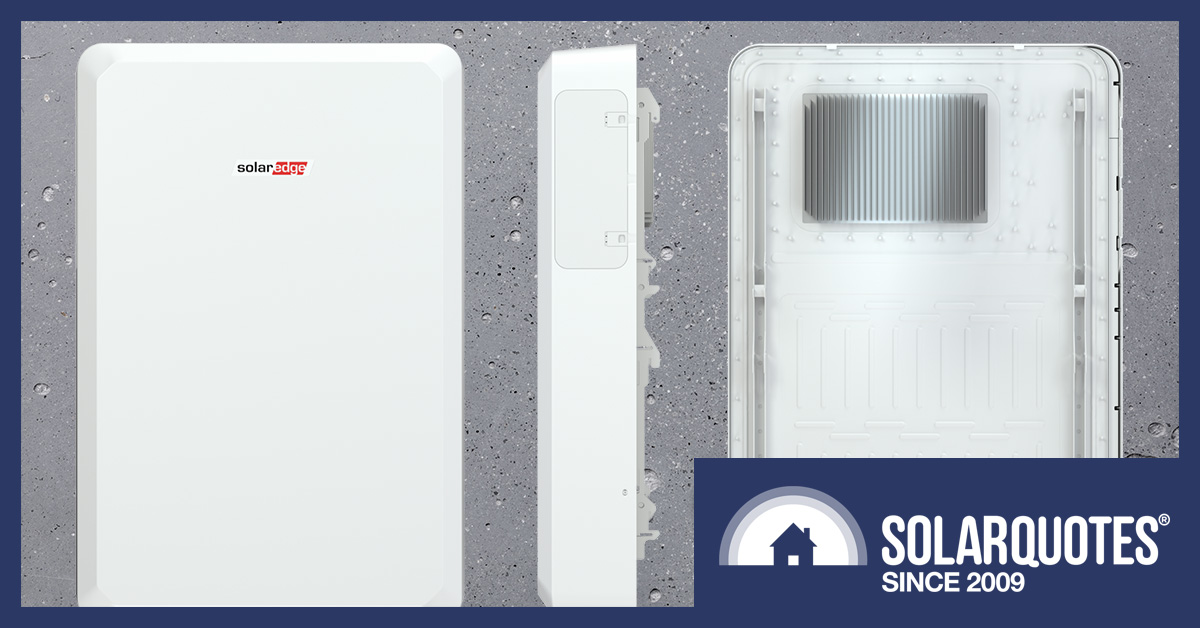
The SolarEdge Home Battery: 9.7 kWh, DC Coupled, Optional Backup
At 4 o’clock last Thursday, SolarEdge launched their home battery with an online event.
The next day, they held another launch for people who couldn’t make it to the first one. I attended both and paid 55% attention each time, so I want you to know I gave this article 110%.
Some important features of the SolarEdge Home Battery are:
- It has 9.7 kilowatt-hours of usable storage.
- It can provide 5 kilowatts of continuous power.
- It’s DC coupled.
- It 93.3% round trip efficiency, which is good.
- Back up costs extra.
- Single-phase homes can charge the battery from solar panels during a blackout with the backup option.
- Backup is only available with the SolarEdge Energy Hub inverter.
- It can be used without backup with the SolarEdge HD-Wave Genesis and HD-Wave EV inverters, and potentially the SolarEdge 3φ (three-phase) Residential Inverter in the future.
- Not recommended for off-grid use.
- Price isn’t clear but its installed cost without backup is likely to be under $10,000. Update 3:17pm 29th March 2020: I have been told the installed cost without backup is likely to be over $12,000 with the cost going higher with an inverter upgrade, which will often be required.
The battery can be added to existing solar systems with compatible SolarEdge inverters. SolarEdge says they’ll have a special offer that will allow SolarEdge owners without an Energy Hub inverter to upgrade to one at a reduced price if they buy the battery. This will also apply if people have an existing Solar Hub inverter and want to get a larger capacity one when they have the battery installed.
Because it’s DC Coupled, there’s no internal battery inverter. This can be a big advantage in areas where battery inverter capacity counts towards the total solar inverter capacity permitted by the local DNSP (electricity network).
Tech Specs
Here are some technical specs I pulled from its datasheet:
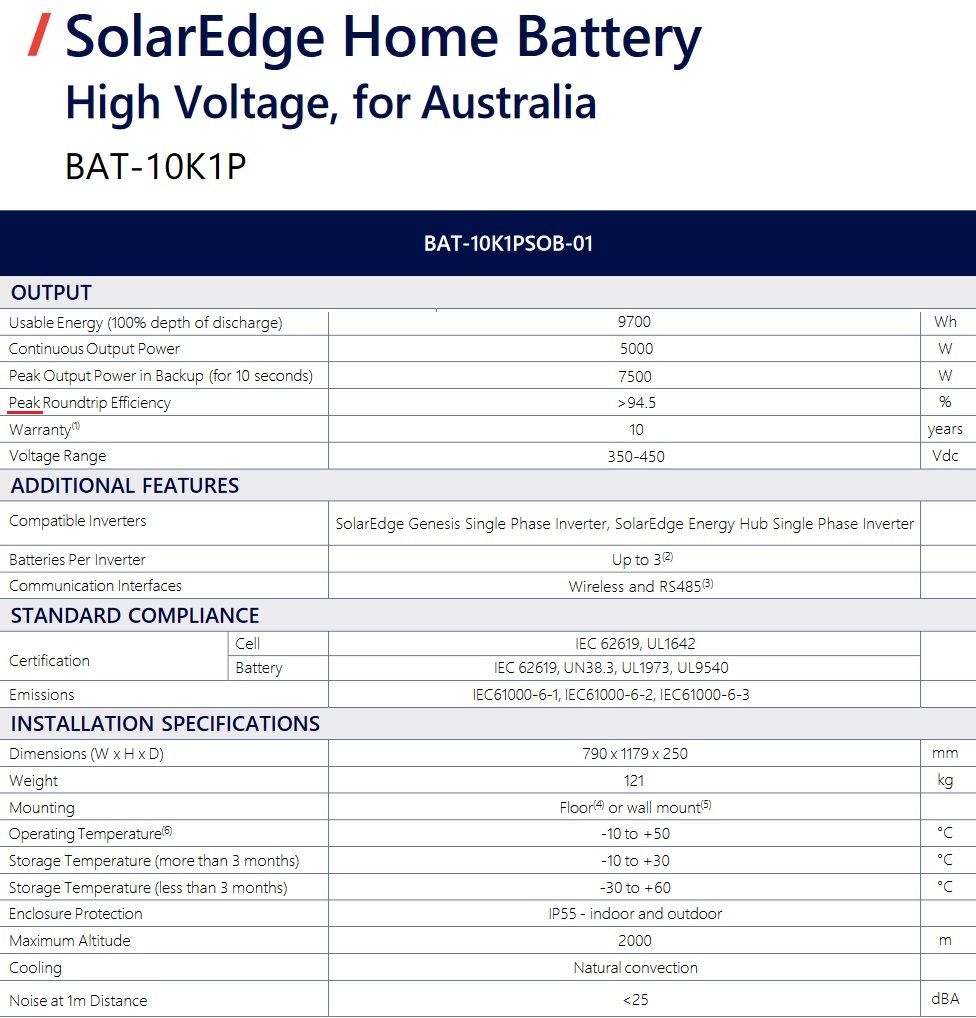
The SolarEdge Battery’s model number is BAT-10K1P, so presumably Bruce Wayne has a dozen of them.
It says its “Peak Roundtrip Efficiency” is greater than 94.5%. I put a red line under the word “Peak” because it’s not the same as the actual roundtrip efficiency, which is around 93.3%.
Energy & Power
It’s a 10 kilowatt-hour battery with 9.7 kilowatt-hours of usable storage. Most households average well under 10 kilowatt-hours consumption at night so, provided the solar system is large enough to regularly fully charge the battery, for a typical household it can potentially eliminate most grid electricity consumption.
Like most home battery systems with around 10 or more kilowatt-hours of storage, the SolarEdge Home Battery can provide a continuous 5 kilowatts of power. While this is enough to meet usual household needs, it’s not difficult to draw more than 5 kilowatts depending on what appliances are used. If your goal is to minimize grid electricity consumption it’s best to use high power draw devices such as electric hot water systems, clothes dryers, and pool pumps during the day when the solar system can directly contribute power.
Multiple Batteries
If 9.7 kilowatt-hours of energy storage isn’t enough, extra batteries can be installed. A Combiner Box will be required, which is an extra expense, and each one will allow up to three batteries to be connected to an inverter. If you’d rather use LG Chem batteries, the Combiner Box can be used with them.
I don’t have any information on the cost of the Combiner Box.
Efficiency
Round trip efficiency is how much energy gets lost between charging and discharging the battery. SolarEdge says for their battery it’s 93.3%. That’s high for a home battery system and is possible because it is DC coupled. The Tesla Powerwall 2 is AC coupled, which gives it the advantage of working with any solar inverter, but it’s only around 88% efficient.
High efficiency is definitely good, but the most important thing for maximizing energy produced is to install as large a solar system as possible. A home will be much better off with one extra solar panel than an extra 5 percentage points of battery roundtrip efficiency.
Compatible Inverters
Backup power requires a SolarEdge Energy Hub single phase inverter and a Backup Box. The Backup Box is an additional expense.
The battery can be used without backup with the SolarEdge HD-Wave Genesis and HD-Wave EV single-phase inverters.
SolarEdge says it should also be possible to install their Home Battery with a SolarEdge 3φ (three-phase) Residential Inverter by the end of the year.
Operating Temperature
The battery’s operating temperature is from -10 to 50ºC. This is a good range for Australia because — at the moment — most towns and cities don’t go over 50ºC even in heatwaves.
But while this temperature range is good, there are there are places that are simply too hot for the SolarEdge battery. Its warranty will be void if installed where the ambient temperature1 exceeds 40 degrees for 5% or more of the warranty period. That’s around 18 days a year. This means you can’t install it Marble Bar in the shade or in a hot tin shed pretty much anywhere. At the moment, Alice Springs should be okay, but note the whole of Australia is getting hotter.
The warranty will also be void if the ambient temperature is under 0 degrees for 5% or more of the warranty period, but outside of the Snowy mountains, this isn’t likely to be a problem in Australia.
Unlike most battery systems, it can be stored for up to a year before use. Its temperature has to be below 30ºC for nine of those months, but being stored between 30 and 60 degrees for 3 months is okay. This makes stock management a lot easier for installers.
Noise
The battery has no active cooling system and relies on natural convection. This just means natural air movement keeps it cool. Because there’s no active cooling, there’s no fan to make noise. SolarEdge says at one metre its noise emission is under 25 decibels. That’s whisper quiet.
Size & Weight
The battery weighs 121 kg and is 118cm high, 79cm across and 25cm deep. This picture gives an idea of its size:
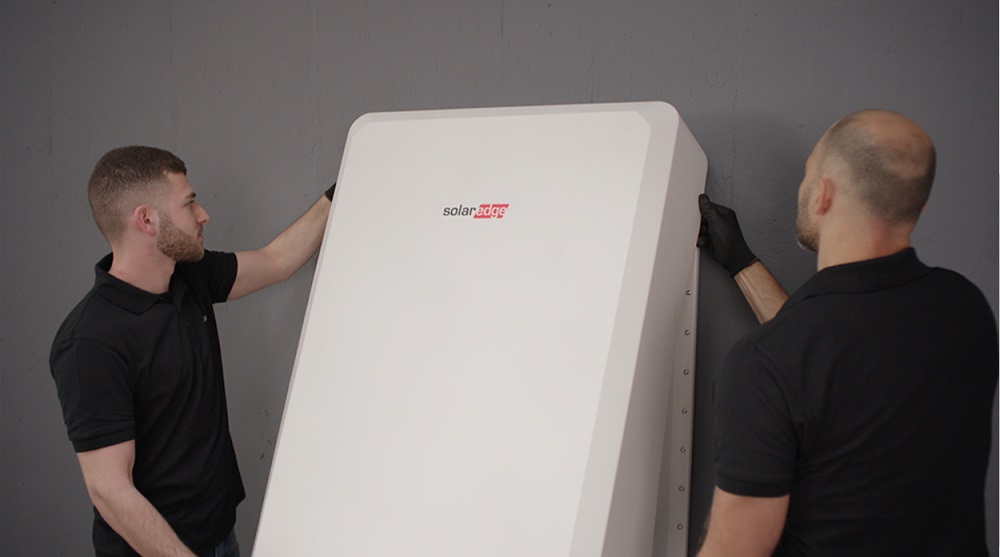
These installers are just putting the plastic cover on. They aren’t casually lifting 121 kilograms. Image: SolarEdge
Note that cabling and the backup box will take up additional space. This is often left out of promotional material that frequently shows batteries installed without the stuff that actually lets it work or, worse, shows it floating in space with “god rays” coming off it:
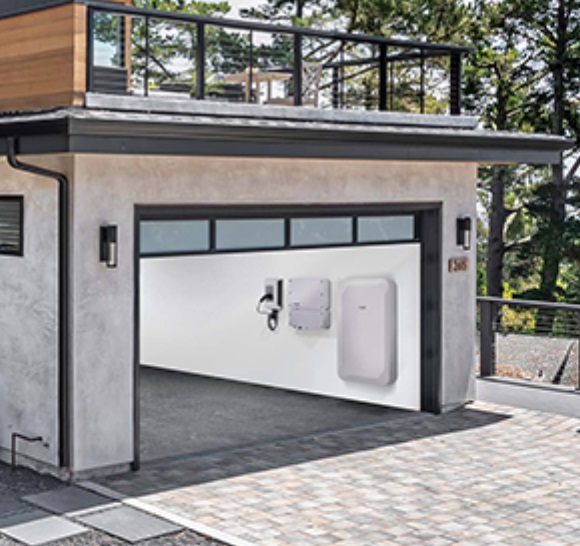
No cabling or backup box is visible in this promotional still. While it’s not impossible to hide cabling, it can significantly add to the cost of installation.
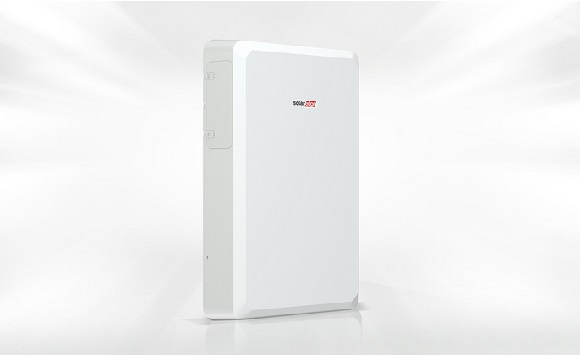
The rays coming off this white monolith indicate it must be the god of all batteries.
Installation
The battery is IP55 rated. This means it is protected from dust and water, allowing it to be installed outside:

While it says it’s protected from jets of water, I really recommend against hosing down your home battery otherwise, you may end up meeting José2 (Image: B&R Enclosures).
While it can be installed outside, SolarEdge makes it very clear it should be installed out of direct sunlight whenever possible. This is because heat is bad for batteries.
The battery is normally wall-mounted, but can be ground-mounted. It comes with a wall mount, but ground installation will require the purchase of a separate floor mount:
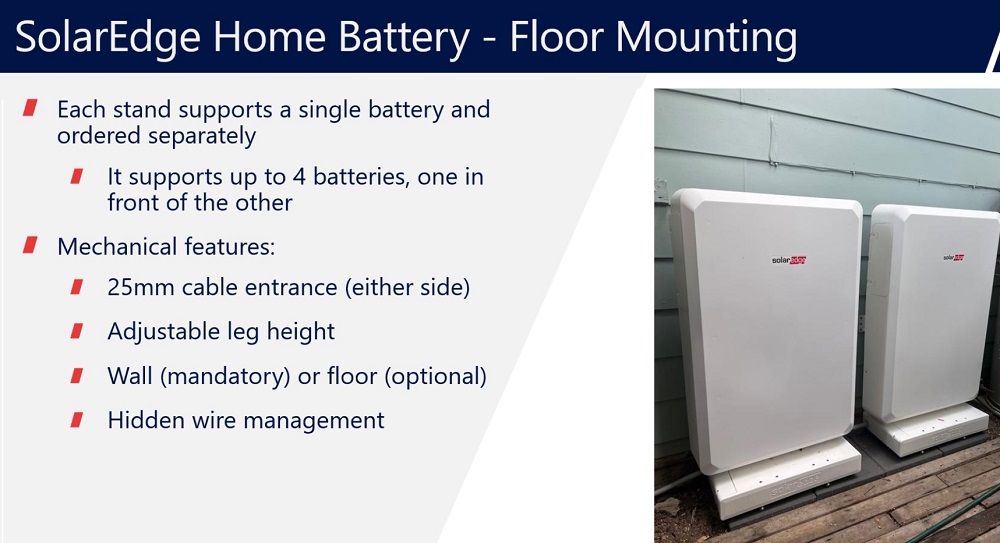
SolarEdge’s description of the floor mount is a bit confusing. One ground mount is required per battery. You can’t put four on one. Also, it’s not mandatory to mount it on the wall, that just means it comes with a wall-mount but you have to shell out for a floor mount. (I hope those batteries aren’t floor-mounted in direct sunlight.)
All communication links can be wireless, which can make installation easier. But because sending electricity through the air is both scary and dangerous, electrical cabling will still be required.
To allow for adequate cooling, the SolarEdge Home Battery requires a minimum of 20 cm clearance all around. This includes underneath when wall mounted. In addition to this, in Australia battery installations now require 60 cm clearance to the sides and 90 cm above3 and not be located inside “habitable” areas of a home.
Backup
When a blackout occurs the optional Blackout Box takes around three seconds to switch to battery power.
In backup mode, the SolarEdge Home Battery can provide up to 5 kilowatts of power, the same as on-grid operation. If you have two batteries and a 10 kilowatt Energy Hub inverter, they can provide up to 10 kilowatts of backup power.
The backup box can support up to three SolarEdge Energy Hub inverters, but each backup box can only supply backup power to a single phase.
By the end of the year, SolarEdge says Backup Box will be able to support a generator of up to 17 kilowatts.
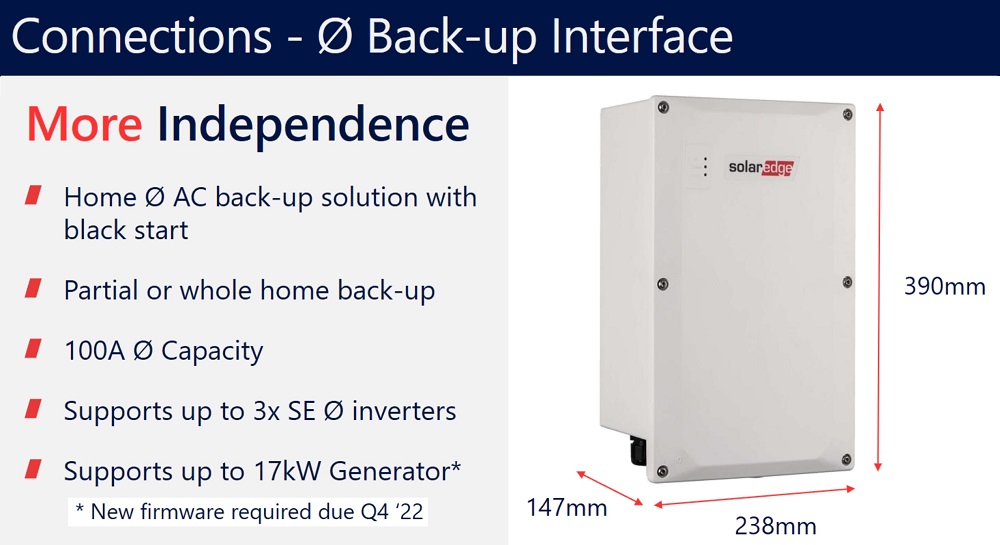
In this graph, SolarEdge refers to it as a φ (single-phase) back-up interface, but at the launch SolarEdge just called it the Backup Box.
Like most home battery systems, it can be set to reserve some energy so you can make sure it won’t be completely flat if a blackout occurs.
The Backup Box will allow the battery to charge from solar panels during a blackout if the home has single-phase power. Even if the battery is completely drained at night during a blackout, it will still retain enough power to automatically switch on and start charging when the sun rises. This is called black start capability.
No information was given on the price of the backup box. I suspect it will add over $1,500 to the cost of installation.
Not Recommended For Off-Grid Use
The SolarEdge battery is not recommended for off-grid use. This is because it doesn’t have surge protection, which makes it difficult to cope with the inrush of current that often occurs when an electric motor starts. The sudden power draw can cause the battery system to trip and shut down. While the motors in modern fridges and freezers are generally not a problem, larger electric motors in air conditioners, washing machines, and clothes dryers may cause difficulties.
Warranty
The SolarEdge Home Battery warranty4 is good compared to most home battery systems.[Update 30th May 2022: Like many home battery systems the SolarEdge warranty requires an internet connection. The warranty makes no mention of how it is affected by disruptions to internet connectivity that will inevitably occur over a 10 year period.] It’s 10 years with unlimited cycles and promises it will have at least 70% of its original capacity at the end of 10 years. Because there’s no limit to the number of cycles, the warranty will last a full decade. It also makes the battery a good choice if you know it’s likely to be used at high capacity.
The warranty says the battery cannot be removed from its original location, but the warranty can be transferred from the original purchaser to another person, provided the battery stays where it is.
I don’t have information on the warranty for the Backup Box or other components such as the connector box. While I hope their warranty length isn’t under 10 years, it would be worth checking if you’re considering buying one.
Battery Chemistry
The battery has NMC lithium battery cells. The NMC stands for Nickel Manganese Cobalt oxide. All else equal, this battery chemistry isn’t as safe as more commonly used lithium iron phosphate batteries — also known as lithium ferro phosphate or LiFePO4 if you prefer letters and numbers — but battery systems aren’t built on the basis of all else being equal. No one just throws battery cells in a box and calls it a day. (If anyone does, you definitely shouldn’t buy that battery.) Battery safety depends on what kind of care and precautions have been taken with the entire system, and I strongly suspect SolarEdge has paid close attention to this.
Built-In Fire Extinguisher
The battery has temperature sensors and if it gets too hot it will send messages to SolarEdge and the homeowner saying there’s a problem. If the temperature rises too high the built-in fire extinguisher will activate and hopefully stop any combustion that may be occurring.
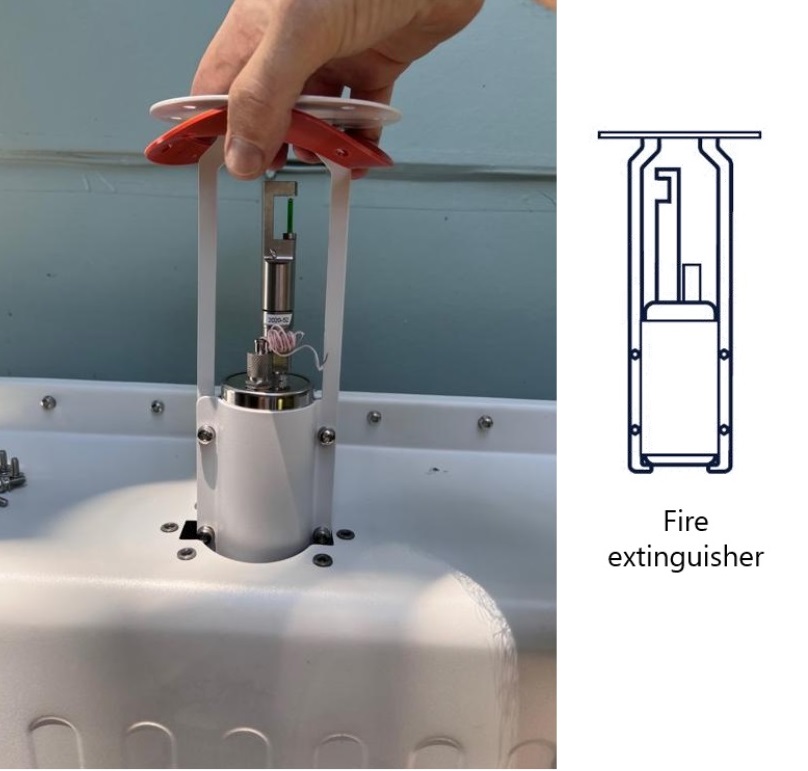
Don’t worry, the installer will slot the fire extinguisher into the hole. You don’t have to stand there holding it.
It’s a potassium nitrate extinguisher that doesn’t use electronic temperature sensors and has a simple heat activated mechanism. Potassium nitrate is sometimes used as a food additive and isn’t very dangerous. I also suspect it will mostly be contained within the battery case if activated.
If the battery is overheating because there is a fault in the Battery Management System (BMS), the extinguisher will take it out and stop whatever it’s doing wrong.
UPDATE SEP 2024: SolarEdge have advised the extinguisher is no longer included as “we were informed that we were so far above the mandatory safety requirements the extinguisher wasn’t needed, so to simplify installation it was removed from that point on.”
VPPs
SolarEdge says households with SolarEdge Home Batteries can join Virtual Power Plants (VPPs) and they are currently in discussions with a variety of providers. Because the warranty has unlimited cycles, it will still last a full 10 years even if joining a VPP greatly increases battery use.
Battery Subsidies
SolarEdge said the battery should be eligible for state battery subsidies in Victoria and South Australia. Once accepted in these states it’s likely to be accepted for any other state subsidies, such as in NSW.
Inverter Upgrades
SolarEdge is offering a special deal that will allow people with existing SolarEdge residential inverters to upgrade to an Energy Hub inverter at a reduced cost if they buy an the battery. This will also apply to people who currently have an Energy Hub but want to upgrade to a larger one. These will be new inverters with fresh warranties. Just how good the deals will be isn’t clear, but it will operate at the installer level and it’s up to them how they’ll pass it on to customers.
DC Coupling & Inverter Limits
A DC-coupled battery, like the SolarEdge Home Battery, shares the solar inverter with the batteries. An AC coupled battery, such as the Tesla Powerwall 2, has its own built-in battery inverter.
Depending on where you are, the battery inverter in an AC coupled battery system can count towards the total amount of solar inverter capacity you are allowed to install, which can be a major drawback. A DC-coupled inverter avoids this problem but requires the battery to be compatible with the solar inverter. This is why the SolarEdge Home Battery only works with specific SolarEdge inverters.
Additional Solar Panels
Generally, on-grid solar systems without batteries can only have a panel capacity that is up to 133% of the inverter capacity. But with a suitable solar inverter and DC coupled battery it’s possible to exceed this solar panel capacity limit. Installing a solar system with a SolarEdge Home Battery, or adding one to a suitable existing system can allow up to an extra 5 kilowatts of panel capacity to be added. If two batteries are installed, up to 10 kilowatts of extra panel capacity can be installed. STCs, which lower the cost of rooftop solar, can be claimed for the additional panel capacity.
This additional panel capacity can provide much greater savings on electricity bills and provide a better return on money invested than the battery.
If the solar panels produce more energy than the inverter capacity then, instead of being wasted as would be the case with an AC coupled battery, the surplus energy can be used to charge batteries if they’re not already at full capacity.
SolarEdge Home Battery Cost
SolarEdge did not reveal the price of their battery or Backup Box. They also didn’t say how much the floor mount or the combiner box for multiple batteries would cost. But a secret squirrel told me to expect to pay under $10,000 for one installed without backup. (If I’m wrong about this, let me know and secret squirrel will be in big trouble.)
Update 3:17pm 29th March 2020: A source even more reliable than Secret Squirrel has told me the SolarEdge Home Battery is likely to have an installed price much higher than $10,000. Without backup or an inverter upgrade its installed cost is likely to be over $12,000. If an inverter upgrade is necessary, that will further increase the price.5
Economics
Given its secret squirrel price, the SolarEdge Home Battery is unlikely to pay for itself through savings on electricity bills alone. But if your electricity use is high, you find a suitable VPP and get a state battery subsidy, it’s possible you be able to come out ahead — depending on electricity prices and how long the battery lasts beyond its warranty.
But there are plenty of reasons to get a battery other than raw financial returns. In which case, for Solar Edge system owners this looks like a well thought out, safe, quiet battery at about the same price as most of its competitors – about $1000 per kWh installed, or more with backup.
Added: If you end up installing one of these batteries, add your thoughts on its performance and features to our SolarEdge Home Battery reviews page.
Update 22 September 2022: SolarQuotes’ Jono was one of the first Australians to install the new SolarEdge Home Battery – check out his review.
Footnotes
- Ambient temperature just means air temperature, but my guess is if the battery gets hot because it’s in sunlight they’ll count that as well. ↩
- Yes, this joke depends on knowing Spanish pronunciation. It’s called niche humour. ↩
- Items associated with the battery, such as inverters and backup boxes, are not included in this 60-90 cm of clearance. ↩
- The warranty document refers to the SolarEdge Home Battery as the SolarEdge Energy Bank. They’ll probably change that soon, as they seem to have gone off that name in Australia. ↩
- I contacted ASIO to inform them of Secret Squirrel’s failings, but they didn’t know what I was talking about. It seems secret squirrel is just too secret. ↩

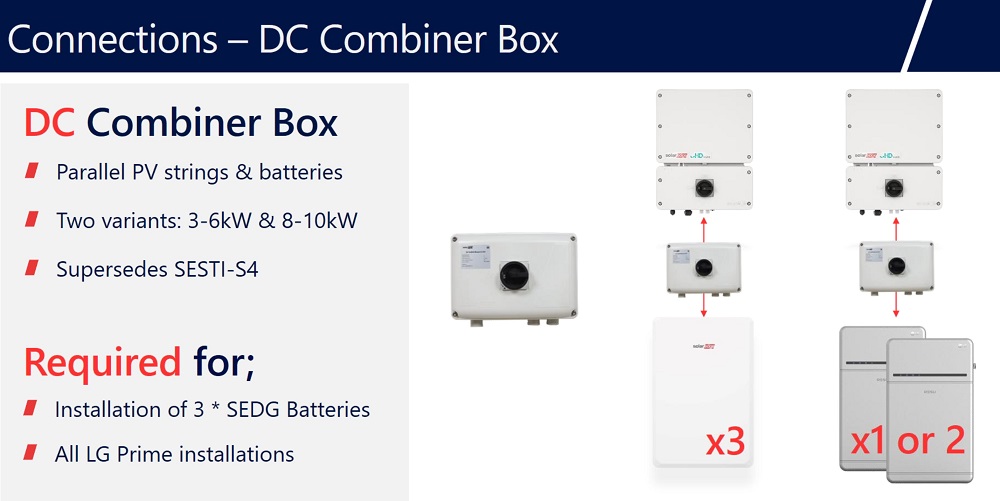
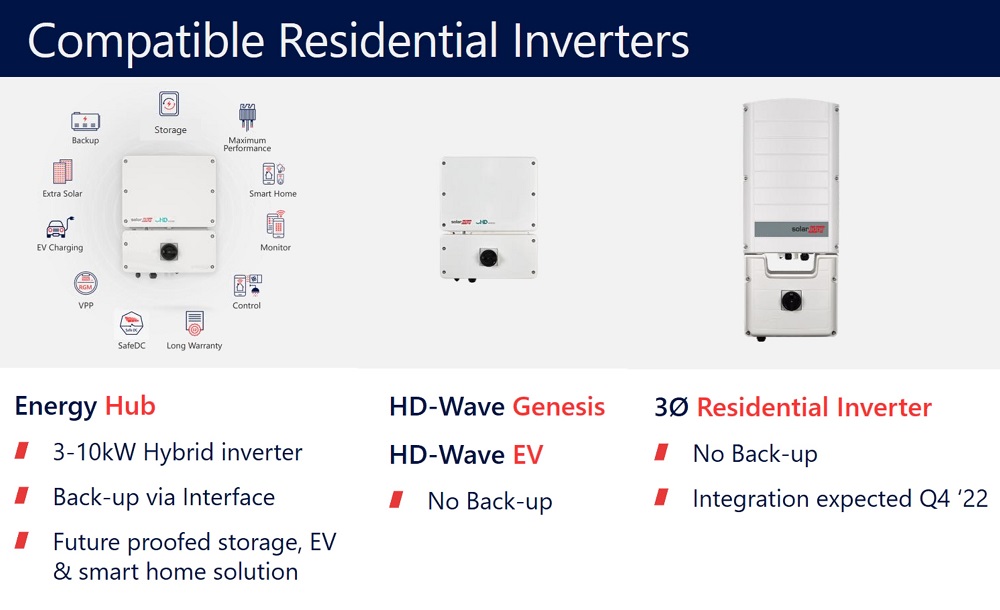
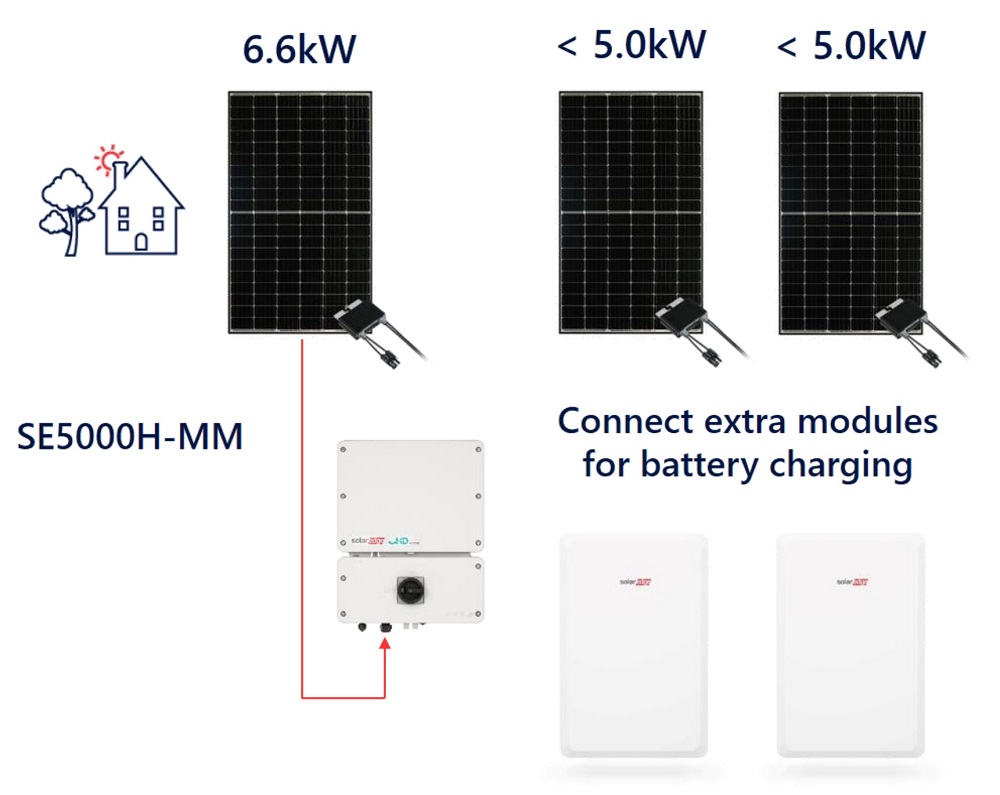
 RSS - Posts
RSS - Posts



I can’t imagine an inbuilt fire extinguisher is going to do much about an NMC lithium battery experiencing excessive heat from thermal runaway. Pretty much nothing can as the cells supply their own oxygen.
Curious as to what it would be expected to achieve?
It’s not a Tesla. It has a different chemical makeup with a phosphate component, so exposure to oxygen won’t initiate a runaway fire I would think.
“The battery has NMC lithium battery cells. The NMC stands for Nickel Manganese Cobalt oxide. All else equal, this battery chemistry isn’t as safe as more commonly used lithium iron phosphate batteries — also known as lithium ferro phosphate or LiFePO4 …”
Thanks – will look at batteries soon, so appreciate all the findings etc.
Being a novice, it seems that the final price on this unit will not be at $10k, but higher once you add on the extra’s +
Be interested if you could do a comparison with the Telsa ?
Sizes, prices pro’s/Cons etc
Thanks Ronald, yet again an interesting article. Thanks for giving 110%.
“ But because sending electricity through the air is both scary and dangerous, electrical cabling will still be required. ” Nicola Tesla would disagree, surely? LOL 🙂
I would love to fit a battery and would do so in a heart beat, not for cost savings but for the environmental benefits of not pulling from the grid in the evening peak, and for peace of mind when the you-know-what hits the fan in a natural disaster, or when our grid fails on a hot summer evening etc.
However sadly – I say that in jest as far as my wallet is concerned of course – I’m on the old legacy FIT in Qld, so it would be economically stupid to do so, kind of like masochism. I would of course then lose my premium FIT immediately.
In the meantime I’ll hope for no serious natural disasters leaving us without power, and continue to charge my Model 3 either on a very sunny day when solar is really pumping, or after midnight.
As I said- thanks ?
Excellent information, well structured, and easy to follow.
But.
Why are these batteries so damn expensive?
Is it to cover the research and development?
In these current costly times, it’s just another impossible amount to find in the household budget.
One reason this particular battery is expensive at the moment is there has been a big run-up in raw material and component prices over the past 5 months or so. The good news is I expect them to lower the price of the battery once commodity prices fall, but it may take a while for this to happen.
I paid $5.3K for my Alpha ESS battery about a year ago fully installed through Shinehub, has 9KW effective capacity but better chemistry than the Tesla from what I understand. I didn’t even have to pay upfront, interest free over five years.
It has remote monitoring software so I can program it to charge at a fixed time from my mobile phone.
I have had no problems whatsoever with it and its a good looking sleek unit.
I DONT UNDERSTAND WHY PEOPLE DONT TALK ABOUT THIS BATTERY AND HOW CHEAP IT IS. I FEEL AS THOUGH I MUST BE IN A PARALLEL UNIVERSE.
Shinehub have specials now and then, they were even offering a similar battery, same make but different module for $2K last year fully installed.
This is probably why: https://www.solarquotes.com.au/blog/alphaess-battery-warranty/
I got a quote in WA a couple of months back (indicative before release) from a SolarQuotes recommended installer of “$11990-12490 depending on install” that included “black out protection as well.” I already have an Energy Hub inverter.
Given that I have seen some other indicative quotes on the Backup Interface in the $1500-2000, this put the battery installed at about the $10,500 for my estimations. Given the “WA tax” this is inline with your secret squirrel.
I also put together a spreadsheet for the battery based on my usage, round trip efficiency, days of full use vs days of 75% use, battery degradation at 3%pa and a bunch of other variables. This put the payback period in WA at 11 years for full cycle usage on the battery at one cycle per day (not saving the 20% for backup use). Of course there’s a number of assumptions there.
“Not suitable for off grid”
Isn’t this the status during backup in a grid failure?
Do we need to be alert to the 3 second delay in switch over, so as to run around & shut down any larger induction motors?
Typically households will be fine as they normally don’t have large motors running, but if the backup power doesn’t come on, then yes, I would recommend switching off induction motors.
In that case it looks to me as though it would be worth fitting a solenoid breaker that drops out when the power goes and requires manual reset?
Or has a time delay reset?
I looked at getting a battery when we installed a new solar system but if I can’t use it ‘off grid’ than what’s the use? Also, I am starting to have doubts about things like this being so good for the environment. Are we replacing coal mines with lithium and other rare minerals? Are we going to regret all the solar panels that need to be replaced at some time. What is the world going to do with all those – in landfill?
Had a quick look at this but keep wondering why I would spend that money but still have no power during an outrage? Better buy a solar generator instead for emergency use? Would love to get some info on those – like the Ecoflo one that is 3Kw. Anyone have input?
If your system includes the Solaredge backup interface, you will have backup (though perhaps with a few seconds interruption between when you lose power and the battery takes over).
No I don’t have Solaredge.
Yikes. I’m too chicken to use LiNiMC batteries for my household. They were in my car when the battery pack caught fire and burnt the whole thing to the ground, and there is no option to highest energy-density for mobile use.
LiFePO₄ is less likely to burn us all to death in our beds, but any Lithium-ion chemistry is destined to be buried in the ground at end of life, in the absence of any other options.
Zn-Br flow batteries are currently the only realistic, fire-retardant, refurbishable option.
Totally agree that LFP is better suited for stationary applications (Tesla is going that way, as well as for their shorter range cars).
Hopefully EOL batteries won’t end up in landfill if companies like Redwood prosper:
https://www.redwoodmaterials.com/
As a solaredge shareholder and installer I’m disappointed in this unit. It’s too big and cumbersome to install with one guy and it’s expensive. We won’t be installing these and will install lgchems new prime batteries which solve the above problems. Disappointed when I saw all the specs on these six months ago.
So you would recommend the LG chem over the solar edge battery yes? As I have been thinking about a 10kw battery for home and Lg chem resu 10 was winning and just noticed solar edge batteries then your post.
I would not recommend either the SolarEdge or LG Chem batteries as they’re both NMC batteries and therefore cannot be guaranteed to be safe.
Installed cost well over 1000 per kWh.
Other established companies such as BYD sell for about 750 per kWh if you shop around and server rack batteries from Australian suppliers for about $600 per kWh – which is is for safer Lithium Iron phosphate LiFePO, safer than Lithium Ion. Even cheaper still from overseas but less backup.
I was considering the Solaredge Solar Battery given the lower cost at $8900 vs $11500 for a Tesla Powerwall 2, but after seeing the comments re NMC battery safety and the rather concerning inclusion of a fire extinguisher, doesn’t give you a lot of confidence in the product.
Just a question on cost, it seems that the installation cost for a battery is around $3-4K. That seems like an awful lot for a half to one days work is it not. I have an electronics background and it seems to me that bolting a battery to the wall and a bit of local electrical wiring and switches is not a lot for 3K. Really what are you getting for that amount of money. I would be interested on others (polite) views on that.
With a big feed in tariff why would you charge your car through the day? Wouldn’t it make more sense to send every kWh you can back to your retailer and use as much power from the grid after solar has finished for the day?
This would only make sense if you had one of the few remaining high feed-in tariffs. For the large majority of solar homes, grid electricity costs considerably more than what they get in solar feed-in tariff.
Thanks Ronald,
Great Article, Clear and Concise, But a quick clarification
I noticed in the backup section.
“The backup box can support up to three SolarEdge Energy Hub inverters, but each backup box can only supply backup power to a single phase. ”
Currently running 3 x Home Hubs (SE6000H) with oversized to 7kw on each inverter.
So I’m just confirming your comments, that the 3 Home Hubs could charge the battery but only one hub could provide power in a blackout case. Also based off this design would the other 2 home hubs function in a blackout (eg: charge the battery, even while technically not receiving a backup circuit).
You’ll need to check with SolarEdge for a definitive answer, but my understanding is one to three SolarEdge batteries and one backup box can be connected to one of your Energy Hubs and it could supply backup power to the phase it’s on. The other two Energy Hubs would not function in a blackout. The SolarEdge Battery (or batteries) would, unfortunately, be unable to charge from solar during a blackout.
When there’s not a blackout all three of your Energy Hubs could effectively charge the battery as far as your electricity meter is concerned.
Hi Ronald,
Thanks for the info. I have contacted the installer(EnergyAssist) who installed my solaredge system and it seems I only have two options for batteries: Tesla or Solaredge, in which the second option would require a change of my current solaredge inverter to be compatible with the batteries. This is what they quoted me:
$11,900 less Solar Vic rebate of $3,500 = $8,400.
This includes
5kW SolarEdge Energy Hub
10kW SolarEdge battery
And installation (subject to confirmation)
Personally it doesn’t seem expensive but I don’t know much about inverters and if they are swapping our existing inverter to be compatible with the batteries, will the new inverter be compatible if we decide to switch to tesla powerwall?
When I first bought the system, I was told by the installer that the system is futureproof with plenty of battery options. If changing to this new inverter + battery setup means I have no chance to shop around for batteries in future, isn’t it a bad idea?
Please provide some enlightenment.
Let’s be honest here… NMC is not safe. LFP or flow batteries are safe and a much better option. Also, why are these reports always focussed on single phase installations only? This is very frustrating for those of us with a three phase supply to our homes. Considering we’re likely to be generating more solar power, as we can feed it in to each phase of the grid, you’d think we’d be even keener and bigger adopters of batteries?
Nigel, unless you declared it somewhere else you are not a chemical or battery engineer or designer.
You cannot say “NMC is not safe” because it is your opinion only based on very little fact that is available right now. A lot of batteries sold in Australia are NMC including Tesla, Samsung and LG and now SolarEdge. There have been no fires reported. So everything you have said here is your stated opinion only.
This is a very technically driven site and people like myself come here for technical solutions and information. I believe engineers not hearsay.
Please do not make absolute statements when you don’t have the all evidence to make them.
Having spent the first 15 years of my career as an industrial process control engineer, I’ve worked with many industrial chemists to understand their process and whilst their knowledge of the chemistry was unquestionable, their knowledge of the challenges and limits of controlling the process, was often surprisingly limited. As such, I do feel qualified to comment on this blog and will continue to do so.
NMC chemistry does have a point where thermal runaway cannot be stopped, resulting in a fire, whilst with LFM chemistry this is virtually impossible. This is the reason why Tesla are (very) quietly switching from NMC to LFM, as they’ve had a number of very well publicised battery fires. Tesla is probably the only large scale comparison for the two chemistries, as far as I’m aware, so that’s the primary evidence we have to go on. Smaller scale batteries, such as those in phones, are also NMC chemistry and also have the occasional one go up in flames. The fact that the numbers of them that do is so small is testament to the battery management systems, not the chemistry.
It’s also true that the smaller the device the higher the energy storage density is required in order to provide acceptable battery life. In the case of home batteries, size is not as much of a determining factor and therefore it’s hard to understand why NMC is used at all under these circumstances. Fortunately there are a number of other promising chemistries under investigation, some of which contain materials that are fire retardants, which is even better!
Whilst there are still organisations manufacturing NMC based Li-ion batteries for home use, it’s up to the home owner to determine the level of risk they’re willing to accept. I acknowledge that this is an individual decision, but I encourage people to research this decision thoroughly prior to committing.
I’ve just had a 6.48 kwh system installed with a 5kwh HD-Wave inverter. I now realise I need a battery or two and have plenty of room on my shed for another set of panels and inverter to which my installers said that they could sell me another 6.4kw system with a Solaredge single phase Hub and 2 batteries. However my problem is that im in an old home with 3 phase residential power (which I’ve just spent $5k on new wiring from the pole to the panel and cct breakers etc in a new box) – now the installer said that I could have backup capability with 3 batteries and all my 3 phase circuits would be backed up thru the smart meter! However I’m an old avionics tech and I understand most of how my house is wired, but I don’t get how one phase is going to power the other two in a blackout thru the new smart meter.
I’m afraid I don’t understand myself what the installer is planning. It’s possible he means something like configuration #11 in the following article:
https://www.solarquotes.com.au/blog/home-batteries-3-phase/
…but that is not a low cost option.
Too true Ronald! I have been reading the article you posted here and I’m rethinking rushing out to get batteries at the moment (I also read “The Six Biggest Myths About Battery Storage”). I’m still going to get another system installed on my garage roof though.
Now config #3 states: “When this battery power gets to the 3-phase meter, the meter subtracts the power being exported on the battery phase from the power being imported on the other 2 phases to give you zero net imports as far as your billing is concerned.”
However, my usage on my AGL app looks like my usage has skyrocketed and the solar is not helping out in creating near to zero net imports… I’m concerned that the new smart meter or the retailer is not giving me the net import but charging full rate for ALL of my usage on the two phases that do not have the solar feeding back in. I am seeing my solar feed in returns but they don’t come close to my useage at the moment.
A bit of good news — well, it’s sort of good news — is I’m not aware of any three phase meter not being configured correctly. But if you are unsure, you can turn of appliances and check your electricity meter in the middle of a sunny day. Then turn on appliances on either phase and see if the meter records you as consuming grid electricity or if your solar system is meeting demand. I suspect your exports are down at the moment because it’s June, which is the worst month for solar, and because electricity consumption tends to go up in winter.
Answer is, it can’t. Backup on 3 phase can only power a single phase and you need to make sure the circuits you want are on that phase.
We had a SolarEdge solar system installed approximately 2 years ago with the system set up by the installer that we can add a battery/s to it at any time in the future. We have been researching batteries at this time and were hoping that, if we had a blackout or planned power outage, that we could rely on the battery/s for power during that time.
We have been advised that that is not possible and that the battery power would only be available when there is no solar power being generated ie at night time. This defeats the purpose somewhat of our intended use of the solar system, and believe now that we can only use the battery power if we were totally off the grid.
Can someone please explain why this is the case and why we wouldn’t be able to use battery power during blackouts and planned outages.
Many thanks.
Trevor,
Either you have been given nonsense information, or you have misunderstood the advice.
A properly installed battery with backup configured to maximise self-consumption works like this 24 hours a day:
Scenario #1: Not enough solar being generated to power your home: The battery supplies the extra power, so that you draw nothing from the grid. If the battery runs out of energy – you start importing from the grid. If the battery runs out of power, you start importing from the grid.
( difference between energy and power is explained here: http://www.solarquotes.com.au/blog/kw-and-kwh-what-is-the-difference/ )
Scenario #2: More solar is being generated than your home needs. Your home is 100% powered by solar and the battery charges from the excess solar.
Scenario #3: The grid goes down. Your battery system isolates itself from the grid and your home is powered by the battery and solar – if there is any solar available. When the grid is restored the battery system reconnects to the grid.
Some battery systems cannot do scenario #3. i.e if the grid goes down the battery system and solar go down too and you are blacked out. Do not buy one of these systems.
Some batteries can do a partial version of scenario #3 – if the grid goes down, the solar shuts down but the battery still kicks in and you get all your power from the battery. If you have a 3-phase solar inverter and a single-phase battery, you’ll be in this situation.
Finn
I have a SolarEdge HD Wave inverter, Backup and DC Combiner and SolarEdge Home Battery High Voltage for Australia BAT-10K1P.
This system was installed on June 10th by Solahart.
I also have the Solahart Powerstore hot water system. My usage currently in winter is 28-32 KW per day and my house power is 3 phase..
I have the Combined Energy CET gateway to report and control the total system.
I have been waiting for the SolarEdge battery since Dec 2021 and so far have not been disappointed particularly as the solar yield for this winter has not been stellar.
I originally had the SolarEdge SE5000 StoreEdge but this were replaced for no charge as part of the installation deal.
Despite the article posted, this system does backup. As it is a 3 phase system I had to decide what power circuits needed battery support but I prefer that anyway as I have more control over what the system does.
All the information I can find says that the SolarEdge HD Wave inverters are single phase only, yet you say that your house is 3 phase? Are you able to point me at the information you have that describes a 3 phase HD Wave inverter, please? Also, the information I have is that the new SolarEdge battery is a Li-ion NMC chemistry. I’d be interested if you can confirm this because that’s a fire risk I’m not prepared to take. If it was Li-ion LFM chemistry, then that’s ok. Thanks.
Nigel Page –
1.You can run a single phase inverter on a three phase house power system. The detail might be on this site. You need to research it.
2. NMC is not a concern for me. After LG Chem had to recall all its RESU10 batteries in Australia I have no doubt that SolarEdge, an Israeli company, will make sure it doesn’t follow that path. Some comment has disparaged the in-built fire extinguisher but it wouldn’t be there if it wasn’t proven to work on this battery.Engineers and companies don’t make superfluous investments like that without it being effective. My battery is locate in my garage at the extreme end of my house. However your risk appetite is up to you.
Thanks for the info, that’s very helpful.
No-one can guarantee the safety of NMC batteries – sadly, that’s just a chemical fact. Please remember that the purpose of a fire extinguisher is to starve a fire of oxygen, but a chemical fire doesn’t need oxygen. I’m sure they had a reason for putting it in there, but they certainly haven’t been forthcoming with what it is. Also, you don’t need a fire extinguisher if there’s no risk of fire!
One purpose of the extinguisher is mentioned in the article:
“If the battery is overheating because there is a fault in the Battery Management System (BMS), the extinguisher will take it out and stop whatever it’s doing wrong.”
As I said, it’s not a concern for me.
On the LG RESU10 – “At this stage in Australia, there had been no incidents recorded in Australia connected with the batteries, with LG issuing a recall “out of an abundance of caution.”
This is a different product, more than likely with packaging and improvements to reduce the likelihood further.
I’m not discussing this aspect any further. I’m happy to answer any other questions.
What modes of operation are available for power prioritisation and charging? I saw in the FAQ that there are modes that can be set in SetApp and hint of user selected modes as well? Can you preference power to Battery or Hot Water for example?
Has the system been configured to charge with excess solar at the DC level? Eg 6.5kW in from panels, 5kW inverter, 4kW in house would push 2.5kW into the battery (crude example I know)
Have you seen any settings for EV charging in options? I have been investigating the Solar Edge EV Charger as another way to tie the solution together.
Modes for the SolarEdge Australian battery are:
Backup only – Set the system to supply power to backed-up loads only in case of a power outage.
Time of use – Set a charge/discharge profile and the level of charging the battery from AC.
Maximum Self Consumption (MSC) – Set the system to maximize self consumption,and then the level of stored energy to be reserved for backup.
There are other modes that were available for the StoreEdge inverter but I don’t know whether these are available for the HD Wave Genesis (the only SE inverter compatible for this Australian SE battery)
These must be setup in SetApp and are unavailable through MySolarEdge App.
My system is running on MSC.
Re solar excess, I believe so as this is described in SE’s Q&A as follows;
Q17: I understood that the battery can be recharged while the inverter manages the grid feed to maximize production from the panels even by oversizing the system. Especially in the summer, is there a battery recharge mode, especially in the middle of the day?
A: It is possible to customize the storage profiles via specific functions in the Monitoring Platform. However, if there is excess PV production in the morning, this energy will be stored in the SolarEdge Home Battery, instead of being fed into the grid.
That could apply to EV charging but a specific question would have to be put to SE Support.
“These must be setup in SetApp and are unavailable through MySolarEdge App.”
This is a TOTAL deal breaker.
I will not purchase this battery with such a dealer only locked down ecosystem.
So until SE give control to the end user they can all take a hike!
Just MO!
Hadn’t seen that – thanks. So, it has no impact on thermal runaway, which is the more dangerous fire that the extinguisher can’t stop. Fair enough I guess, but unusual to protect a BMS like that.
I suspect that by limiting external oxygen, the extinguisher may reduce the initial intensity of a fire, but I don’t know enough to say.
Hi
I have a Solaredge Energy Hub inverter and am considering the SE over the Tesla PowerWall 2
Who sets, configures and then changes the controls of the SE Home Battery smarts?
Is this something the homeowner end user can do easily via the mysolaredge app or a web interface, or does the owner have to ask the dealer and or SE help to change settings?
Thanks
Bump. Can someone please tell me if this battery supports end user adjustment of things like time of use (to make the most to using the battery during peak hrs and charging it off peak – if the sun hasn’t come out the day before) thanks!
At some point we will be getting someone who owns a SolarEdge battery to do a write up on its details. I presume it’s capable holding off on discharging the battery until the peak period starts, as that’s simply a matter of software. But sometimes I am surprised by a lack of functionality in a product from a company I would expect to be on top of these sorts of things.
Hi
I’ve had a solaredge battery since June and so far it has been great! I am a tinkerer so have hooked the solaredge inverter to home assistant using modbus tcp. Through this I have control of the battery charge/discharge and export limitation. I am with amber and import/export according to spot prices and forecasts through their api.
The solaredge app does not allow this control. Another way of controlling it is through amber who can either control it for you or you can use their app to control it.
Let me know if you need further information
Cheers
Matt B
Hi Matt
Just so you know, Jonothan here at SolarQuotes has lived with a SolarEdge battery for three months and written about his experiences here:
https://www.solarquotes.com.au/blog/solaredge-home-battery-review-2/
Sounds real nerdy but sounds awesome – can you please post the details or links to forums where you discuss this? How you have done it. It sounds complicated and sharings API’s etc in my experience can break with lots of third parties involved.. But I would sure like to know how you put all this together. thanks!
Hi
Yeah it is pretty nerdy but it is rewarding!
Link to home assistant (open source automation)
https://www.home-assistant.io/
The solaredge modbus control is here:
https://github.com/binsentsu/home-assistant-solaredge-modbus
Link to amber api plugin for home assistant:
https://www.home-assistant.io/integrations/amberelectric/
Using the above I have created automations in home assistant that read the current electricity price for import/export and either restrict export (when export price is negative) or turn on devices (pool pump and air conditioners) to make use of excess solar/negative import prices. My system exports when the price is above 10c during the day or over $3 at other times. The battery charges from the grid anytime the import price is below 5c (I.e excessive wind or solar)
This is pretty much what amber smartshift does but with additional control of devices to soak up excess power.
My goal with this automation is that I am hoping for a negative bill every month but we will see (last month was -$45 – this month might be -$5?)
Next winter I think I will get a storage heater to further offset energy usage
Cheers
Matt
@Matt B what state are you in? I’d love to get in contact to see how this works.
Matt B.
I have gone down your Home Assistant/Amber/SolarEdge mixing API datafeed into Home Assistant rabbit hole. Not actually (yet) but metaphorically.
This looks an unbelievable option. Kudos dude for putting this together. You are awesome. What a solution! In that you hack the data from the SolarEdge inverter and battery and have a workaround to control the battery thru the Amber Power offering (and app)?
There seems (however) so many dependencies for this to continue to function and give you the cheap power that we all want, and a way for the 10K + home battery we purchase to be financially viable (and pay for itself) in the life of the battery.
So my question is this.
Have you considered all the possible and ? likely redundancies for this to continue for 10 years (the life of the battery) as a viable option?
1/ Home assistant. Open source platform. Resides on Raspberry Pi in house.. sure.. but Hackable from outside? Where is the financial incentive (from the developers point of view) to keep this platform running the next 10 years?
2/ SolarEdge. Currently sold thru a dealer only model. API (I thought) was locked (Dealers program and adjust things like battery smarts thru SE SetApp.) What if SolarEdge in the end don’t like the backdoor into their API being used “outside” and change the rules (ie lock it down)?
3/Amber. Looks unbelievable great as a electricity retailer at first. But are they too good to be true? In the end you are locked into their ecosystem. Don’t they basically steal the use of your battery? What if a year or two down the road they jack up the user fee prices, or slash the buyback rates and you want to jump ship? Yes there are no lock in contracts with Amber, but what do you do then with your ability to look into your power use and control the home devices you are using and set the changing parameters of your battery? What if (for example) you really decide to go off grid and take back control?
Love what you’ve done Matt. J
Hi
I’m in south Australia..
Yeah the system I have is constantly evolving for various different variables, I watch it like a hawk but after a year can probably trust it is working correctly..
1. Home assistant I have been using for the last 6 years, it is very stable now and their financial incentive is a subscription model called nabu casa that I pay for.. otherwise it is the 2nd most active python project on github! So is mainly community driven and not reliant on a small group of developers.. My home assistant instance is not exposed directly to the internet but through nabu casa which yes I suppose, as is everything, prone to getting hacked at some point.. I only have the nabu casa for my pool sensor so if I find a way to get that info locally then I will switch off the outside connection completely..
2. Its not their api but modbus tcp which is all local network.. Solaredge use modbus to communicate with all their devices so this is not something they can switch off. If they switch off modbus tcp then a modbus tcp converter device can be used.
3. I don’t actually let amber control my devices, i just use their api as inputs. Home assistant controls it all as there is a lot more smarts that can be done in home assistant simply because of the access it has but I see the benefit of people using smartshift if they don’t want to go down the rabbithole..
This is the first time I have shared any if this info so appreciate your questions!
Cheers
Matt
I installed my first 30kWh of batteries (NOT Li-ion! ?) 18 months ago, with the objective of exporting 5kW to the grid (single-phase houehold limit in Darwin) 24 hours per day. So far, I export a maximum of 1000W from batteries to grid, starting at dusk.
An electrical conttactor told me yesterday that exporting from batteries to grid is not allowed! I was surprised, since that would “flatten the curve” for the utilities. I understand the need to stop exporting if there’s a grid outage.
Does this ring true?
Very informative, but I’d like more insight into the battery profile modes.
Namely, exactly how does maximize self consumption work and the same for discharge to minimize import.
I wish I could tell it to charge to 100% and then do nothing until the high usage tariff kicks in.
Maybe Charge from PV – that says it will use PV to charge it to 100% and then use PV for other things. But will the battery sit at 100% until you tell it to discharge to minimize import? and if you have excess PV above and beyond what the battery can charge at, will that PV be used for self consumption or just exported?
many questions …
Note: My SE battery worked for 2 days (Jan 2 and 3 2023) and then died. It is now March 26 and SE finally got a replacement battery to my installer who is coming out tomorrow morning.
I’ll give an update on how it performs after a couple of weeks. I will need to experiment with Battery charge/discharge profiles as their exact behavior isn’t well explained. Stay tuned.
Tom
The new battery is working well. I figured out a good battery profile.
Midnight to 5 am (low rates) “PV Only”
5 am to 9 am (high rates) “Discharge to minimize import”
9 am to 5 pm (medium rates) “Charge from PV”
5 pm to 9 pm (high rates) “Discharge to minimize import”
9 pm to midnight (low rates) PV Only
Reply to this thread and I can help you understand the charging behavior
I downloaded the app SolarView which can provide a SE battery summary that includes: Rated Capacity kWh , Current Capacity kWh, Lifetime Charged KWh and Lifetime Discharged. For my system (today) the #’s were 9.7 kWh, 9.41 kWh, 2205 kWh and 1592 kWh.
This indicates after 1 year 97% capacity, and a round-trip efficiency of 0.72
This efficiency is nowhere near the stated 93% mentioned above and explains why my system performance has markedly dropped (via comparitive plots) since installing batteries (a Round trip efficiency of 0.72 is equivalent to 0.28 curtailment !!). I’m double checking with the SolarView app writers before raising this issue with Solaredge. I’m feeling disappointed if these numbers are correct.
As of last month – October 2024, I had my SE battery installation, it came with the built in fire extinguisher still. Maybe check your updates.